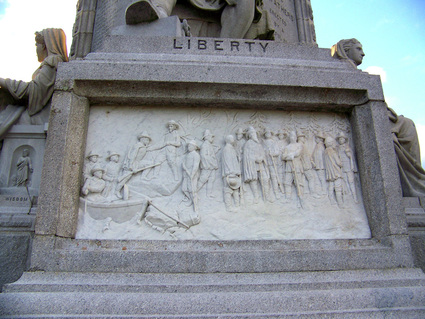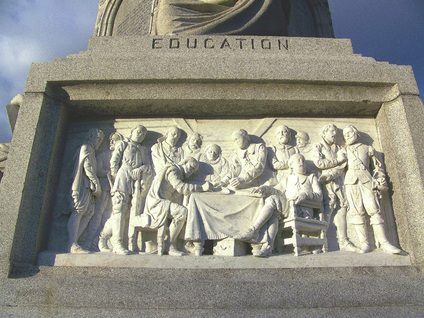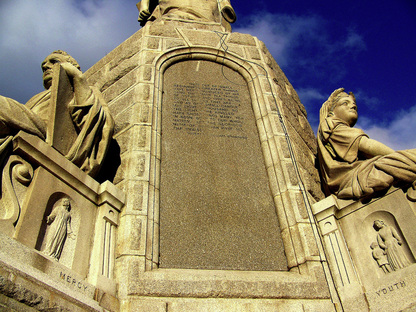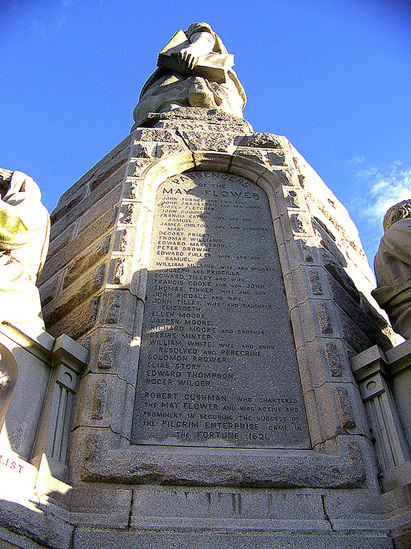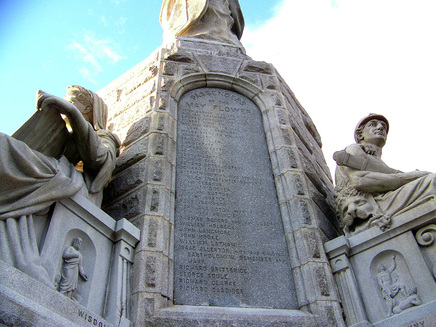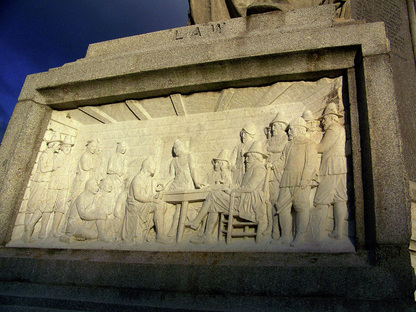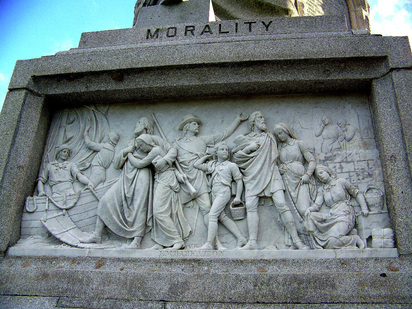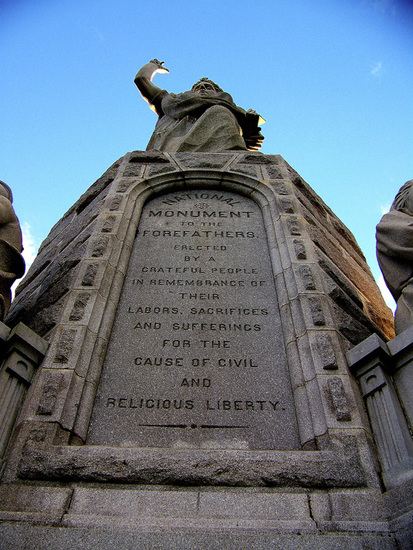National Monument to the Forefathers
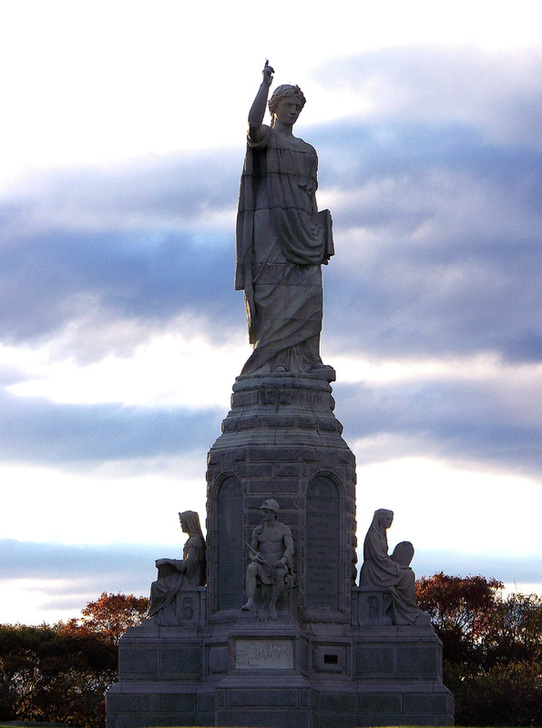
National Monument to the Forefathers From Wikipedia, the free encyclopedia
The Monument at sunset, 2007 The National Monument to the Forefathers, formerly known as the Pilgrim Monument,[1] commemorates the Mayflower Pilgrims and honors their ideals as later generally embraced by the United States. The Pilgrim Monument of the present day is in Plymouth, Massachusetts and was built between 1907 and 1910.
the 81-foot-tall (25 m) monument was commissioned by the Pilgrim Society. The original concept dates to around 1820, with actual planning beginning in 1850. The corner-stone was laid August 2, 1859 by the Grand Lodge of Masons in Massachusetts, under the direction of Grand Master John T. Heard. The monument was completed in October 1888, and was dedicated with appropriate ceremonies on August 1, 1889.[2]
Hammatt Billings, Boston architect, illustrator and sculptor, originally conceived the monument as a 150-foot-tall (46 m) structure comparable to the Colossus of Rhodes. Shortly before his death in 1874, Billings reduced the size of the monument, which was to be made entirely of granite. The project was then passed to Billings' brother Joseph who, along with other sculptors including Alexander Doyle, Carl Conrads, and James Mahoney, reworked the design, although the basic components remained. The monument, which faces northeast to Plymouth Harbor (and, roughly, towards Plymouth, England), sits in the center of a circular drive, which is accessed from Allerton Street from the east. The plan of the principal pedestal is octagonal, with four small, and four large faces; from the small faces project four butresses. On the main pedestal stands the heroic figure of "Faith." Upon the four buttresses are seated figures emblematical of the principles upon which the Pilgrims founded their Commonwealth; counter-clockwise from the east are Freedom, Morality, Law and Education. Each was carved from a solid block of granite, posed in the sitting position upon chairs with a high relief on either side of minor characteristics. Under "Freedom" stand "Tyranny" and "Peace;" under "Morality" stand "Prophet" and "Evangelist;" under "Law" stand "Justice" and "Mercy;" and under "Education" are "Youth" and "Wisdom." On the face of the buttresses, beneath these figures are high reliefs in marble, representing scenes from Pilgrim history. Under "Freedom" is "Landing;" under "Morality" is "Embarcation;" under "Law" is "Treaty;" and under "Education" is "Compact." Upon the four faces of the main pedestal are large panels for records. The front panel is inscribed as follows: "National Monument to the Forefathers. Erected by a grateful people in remembrance of their labors, sacrifices and sufferings for the cause of civil and religious liberty." The right and left panels contain the names of those who came over in the Mayflower. The rear panel, which was not engraved until recently, contains a quote from Governor William Bradford's famous history, Of Plymouth Plantation:
"Thus out of small beginnings greater things have been produced by His hand that made all things of nothing and gives being to all things that are; and as one small candle may light a thousand, so the light here kindled hath shone unto many, yea in some sort to our whole nation; let the glorious name of Jehovah have all praise." The overall scheme was designed by architect Hammatt Billings, with subsidiary statues executed by area sculptors including William Rimmer.[3]
The Monument at sunset, 2007 The National Monument to the Forefathers, formerly known as the Pilgrim Monument,[1] commemorates the Mayflower Pilgrims and honors their ideals as later generally embraced by the United States. The Pilgrim Monument of the present day is in Plymouth, Massachusetts and was built between 1907 and 1910.
the 81-foot-tall (25 m) monument was commissioned by the Pilgrim Society. The original concept dates to around 1820, with actual planning beginning in 1850. The corner-stone was laid August 2, 1859 by the Grand Lodge of Masons in Massachusetts, under the direction of Grand Master John T. Heard. The monument was completed in October 1888, and was dedicated with appropriate ceremonies on August 1, 1889.[2]
Hammatt Billings, Boston architect, illustrator and sculptor, originally conceived the monument as a 150-foot-tall (46 m) structure comparable to the Colossus of Rhodes. Shortly before his death in 1874, Billings reduced the size of the monument, which was to be made entirely of granite. The project was then passed to Billings' brother Joseph who, along with other sculptors including Alexander Doyle, Carl Conrads, and James Mahoney, reworked the design, although the basic components remained. The monument, which faces northeast to Plymouth Harbor (and, roughly, towards Plymouth, England), sits in the center of a circular drive, which is accessed from Allerton Street from the east. The plan of the principal pedestal is octagonal, with four small, and four large faces; from the small faces project four butresses. On the main pedestal stands the heroic figure of "Faith." Upon the four buttresses are seated figures emblematical of the principles upon which the Pilgrims founded their Commonwealth; counter-clockwise from the east are Freedom, Morality, Law and Education. Each was carved from a solid block of granite, posed in the sitting position upon chairs with a high relief on either side of minor characteristics. Under "Freedom" stand "Tyranny" and "Peace;" under "Morality" stand "Prophet" and "Evangelist;" under "Law" stand "Justice" and "Mercy;" and under "Education" are "Youth" and "Wisdom." On the face of the buttresses, beneath these figures are high reliefs in marble, representing scenes from Pilgrim history. Under "Freedom" is "Landing;" under "Morality" is "Embarcation;" under "Law" is "Treaty;" and under "Education" is "Compact." Upon the four faces of the main pedestal are large panels for records. The front panel is inscribed as follows: "National Monument to the Forefathers. Erected by a grateful people in remembrance of their labors, sacrifices and sufferings for the cause of civil and religious liberty." The right and left panels contain the names of those who came over in the Mayflower. The rear panel, which was not engraved until recently, contains a quote from Governor William Bradford's famous history, Of Plymouth Plantation:
"Thus out of small beginnings greater things have been produced by His hand that made all things of nothing and gives being to all things that are; and as one small candle may light a thousand, so the light here kindled hath shone unto many, yea in some sort to our whole nation; let the glorious name of Jehovah have all praise." The overall scheme was designed by architect Hammatt Billings, with subsidiary statues executed by area sculptors including William Rimmer.[3]
